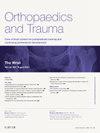股骨头骺滑脱:诊断、分类和治疗争议
Q4 Medicine
引用次数: 0
摘要
股骨头骺滑脱(SCFE)是青少年最常见的髋关节疾病,任何外科医生在值班时都会遇到这种疾病。这种疾病在诊断和管理方面存在许多挑战,尤其是如何管理病情严重和不稳定的儿童。本文将介绍 SCFE 的诊断和分类,以便识别需要儿科专科转诊的患者。文章还讨论了 SCFE(包括复杂病例)的手术治疗。本文章由计算机程序翻译,如有差异,请以英文原文为准。
Slipped capital femoral epiphysis: diagnosis, classification and controversies in management
Slipped capital femoral epiphysis (SCFE) is the most common hip disorder affecting adolescents, and can be encountered by any surgeon who sees children as part of their on-call commitment. There are a number of diagnostic and management challenges associated with this condition, in particular in how to manage children with severe and unstable disease. This article covers the diagnosis and classification of SCFE, allowing recognition of those patients requiring specialist paediatric referral. The surgical management of SCFE, including complex cases, is also discussed.
求助全文
通过发布文献求助,成功后即可免费获取论文全文。
去求助
来源期刊

Orthopaedics and Trauma
Medicine-Orthopedics and Sports Medicine
CiteScore
1.00
自引率
0.00%
发文量
57
期刊介绍:
Orthopaedics and Trauma presents a unique collection of International review articles summarizing the current state of knowledge and research in orthopaedics. Each issue focuses on a specific topic, discussed in depth in a mini-symposium; other articles cover the areas of basic science, medicine, children/adults, trauma, imaging and historical review. There is also an annotation, self-assessment questions and a second opinion section. In this way the entire postgraduate syllabus will be covered in a 4-year cycle.
 求助内容:
求助内容: 应助结果提醒方式:
应助结果提醒方式:


